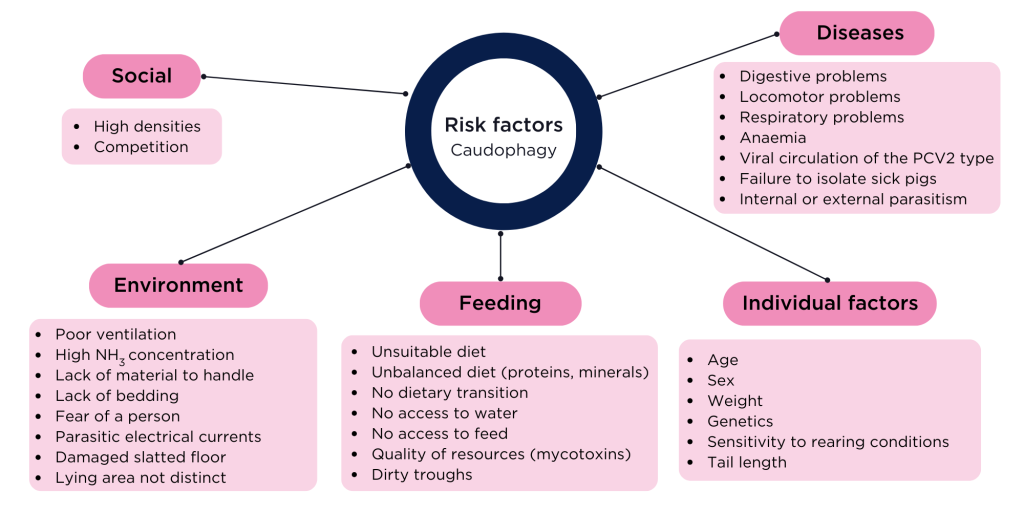What is tail biting in pig farming?
Intensive pig farming can cause stress, leading to abnormal social behaviour, such as tail biting or excessive aggression. Caudophagy corresponds to tail biting and occurs particularly in fattening pigs. This behaviour is considered “abnormal” because it is rarely observed in extensive conditions. In theory, animal welfare in livestock farming should allow the natural behaviour of the species to be expressed by limiting any form of mutilation. The challenge for the pig industry is to prevent tail biting while avoiding routine tail docking (removal of the tail). Caudophagy varies from region to region, ranging from 2 to 8% in the UK, 23 to 28% in Italy and 58% in Ireland, with a European average of 10% (Hunter et al., 2001 ; Scollo et al., 2016 ; Harley et al., 2012 ; Niemi et al., 2021). Scoring grids are used to assess the situation on a farm, such as the one used by IFIP – AccEC :

Figure 1: Tail bite scoring grid (adapted from IFIP – AccEC)
Caudophagy is not only an animal welfare issue associated with stress and pain, it is also an economic issue, as it leads to processing costs, reduced technical performance and increased carcass disposals and seizures (FAWEC, 2018). Economic losses, under current rearing conditions, are estimated at €2.3 per pig in Europe (Niemi et al., 2021). Caudophagy is therefore a complex and multifactorial problem.
What are the main risk factors for tail bites?
The main causes of cannibalism in pigs are related to frustration caused by feed restriction or increased competition for feed resources, a lack of exploration and enrichment of the environment, or stress and discomfort caused by limited space (Moinard et al., 2003). Ventilation problems (draughts, cold walls, wide variations in temperature and humidity), the presence of a sick pig that has not been removed from the batch in time, on which other pigs attack, or gastrointestinal problems increase the pigs’ propensity to chew, leading to tail biting. The main risk factors identified for tail biting are shown in the figure below:

Figure 2: The main risk factors for tail bites
How to limit tail biting in pig farming?
Caudophagy can be limited by identifying and correcting the risk factors mentioned above, to avoid any competitive, frustrating or uncomfortable situations for the pigs.
In breeding, prevention involves cutting the tails. In Europe, more than 2/3 of pigs undergo tail docking, i.e. the removal of around two-thirds of the length of the tail during the first week of life. This handling generates stress and pain (Tallet et al., 2019). Stopping this practice constitutes a response to societal expectations. However, tail docking helps limit the risk of tail biting between pigs and is widely used in producing regions.
The pig is a curious animal and needs to express its need for play or burrowing. This requires enrichment of the rearing environment. In fact, various studies have shown that pens using materials that can be manipulated to allow pigs to express their natural behavior have lower levels of tail biting. Easily destructible and deformable objects such as soft wood, straw or flexible tubing are effective. However, pigs quickly lose interest in any new object, regardless of its physical characteristics. To be effective, handling equipment must be clean and changed frequently.
How can MAG26 help reduce caudophagy in fattening pigs?
Nutrition can also be a lever for improving animal welfare. Our magnesium phosphate, MAG26, is a raw material rich in phosphorus and magnesium. The combination of P and Mg in the same molecule increases antioxidant capacity, compared to an association of MCP and MgO. MAG26, with his properties on cells viability and antioxydant capacity, manage the stress and improves the performances. Manufactured for almost 30 years at our plant in St-Malo (France), this phosphate has won over customers for feeding pigs of all ages without causing intestinal problems. It can be used in finishing period during episodes of cannibalism and aggressive behaviour, or in piglets to ease the transition and try to manage the stress of weaning.
Results from field trials (2023) show that MAG26 reduces caudophagy in fattening pigs and improves breeding performance. There was a significant improvement in caudophagy scores as early as 18 days, as well as a reduction in the severity of lesions in the MAG26 group, particularly for lesions with a score of 3 at the end of the trial.

Figure 3: The use of MAG26 reduces caudophagy in fattening pigs
To know more, you can discover : MAG26 brochure
For more information, don’t hesitate to contact our technical team: technical@phosphea.com!
